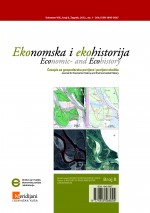Planina Ryohakusanchi: ljudi i okoliš grada Johana
Ryohakusanchi mountain district:People and Surroundings of Johana Town
Author(s): Isao KoshimuraSubject(s): History
Published by: Društvo za hrvatsku ekonomsku povijest i ekohistoriju - Izdavačka kuća Meridijani
Keywords: Japan; Early modern history; silk; textile production; Early modern history; rule of the clan and autonomy of the city; extended family; rule of the Shogunate; sericulture; modernization of society
Summary/Abstract: Johana, a town of silk, is located on the edge of Ryohakusanchi mountain district and had a close business relationship with Gokayama and Shirakawa by trading in raw silk. Johana was founded by the temple of Zentokuji in 16th century. In the Edo period, feudal lord Maeda of the Kaga clan promoted Johana’s economical activities by opening markets and protecting silk textile domestic industry. Johana at that time was a market town, and was the most important town next to the castle cities of the Kaga clan. Although controlled by the magistrate, people of the Johana town enjoyed some autonomy and started to obtain economic power. Servants who came from surrounding villages worked for the ecnomic power of Johana; maidservants as weavers of silk textile, menservants as money collectors running for Gokayama villages nearby. Sericulture had developed since 16th century in Gokayama and Shirakawa because they are surrounded by high mountains and have limited land to be cultivated. People of Gokayama/ Shirakawa raised silkworm by organizing themselves in extended family system, that is similar to the Balkan’s zadrugas. Shirakawa was under the rule of the Tokugawa shogunate and prohibited from dividing their extended families. On the other hand, Gokayama was under the rule of the Kaga clan, and allowed to divide their families in case they have large enough land. Therefore, extended family system had been maintained for long time in Shirakawa and sericulture was developed especially in such area where extended families are concentrated. In Meiji period, a lot of families of Gokayama migrated to Hokkaido and other big cities in Japan. However, extended families of Shirakawa were resolved very slowly. Though, nowadays it is almost impossible to find extended families. Large houses of Gokayama /Shirakawa, were once inhabited by extended families. Today they are registered in the World heritage and are attracting attention of tourists as a symbol of Japanese traditional family and its way of life.
Journal: Ekonomska i ekohistorija - Časopis za gospodarsku povijest i povijest okoliša
- Issue Year: 2012
- Issue No: 8
- Page Range: 80-99
- Page Count: 20
- Language: Croatian

